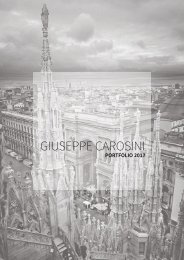Create successful ePaper yourself
Turn your PDF publications into a flip-book with our unique Google optimized e-Paper software.
THE SILK ROAD<br />
ريرحلا قwيرط<br />
Δρόμος του<br />
μεταξιού<br />
ABOUT THE SILK ROAD<br />
The Silk Road was an historical trade route spanning from Chang’an<br />
in China, across the East to Rome. The network of trade routes were<br />
formally established under the Han Dynasty and allowed for a cross<br />
pollination of cultures, exposing the Roman Empire at its other end<br />
to the treasures of the unexplored East. Coined as the “Silk Road” by<br />
Ferdinand von Richthofen in 1877, it was by no means a prehistoric<br />
highway used for the transport of precious cloth from China to Europe.<br />
These vast networks carried more than just merchandise and precious<br />
commodities however: the constant movement and mixing of<br />
populations also brought about the transmission of knowledge, ideas,<br />
cultures and beliefs, which had a profound impact on the history and<br />
civilizations of the Eurasian peoples. Travelers along the Silk Roads<br />
were attracted not only by trade but also by the intellectual and cultural<br />
exchange that was taking place in cities along the Silk Roads, many<br />
of which developed into hubs of culture and learning. Science, arts<br />
and literature, as well as crafts and technologies were thus shared and<br />
disseminated into societies along the lengths of these routes, and in<br />
this way, languages, religions and cultures developed and influenced<br />
each other.<br />
126 REFUGIUM<br />
MORE THAN JUST SILK<br />
The production of silk was one of China’s best kept secrets. The<br />
luxurious material became highly sort after in the West generating this<br />
interest in mystery of the East. The material was used to adorn nobles,<br />
emperors and even tombs. Its opulence was not unnoticed by those<br />
abroad and it was even used as diplomatic gifts between China and<br />
other nations. The trade of silk though opened the door to an expansive<br />
network that comprised of much more. These new passages of<br />
trade which included textiles, spices, grain, vegetables and fruit, animal<br />
hides, tools, wood work, metal work, religious objects, art work,<br />
precious stones and much more. Indeed, the Silk Roads became more<br />
popular and increasingly well-traveled over the course of the Middle<br />
Ages, and were still in use in the 19th century, a testimony not only<br />
to their usefulness but also to their flexibility and adaptability to the<br />
changing demands of society. Nor did these trading paths follow any<br />
one trail – merchants had a wide choice of different routes crossing a<br />
variety of regions of Eastern Europe, the Middle East, Central Asia and<br />
the Far East, as well as the maritime routes, which transported goods<br />
from China and South East Asia through the Indian Ocean to Africa,<br />
India and the Near East.




